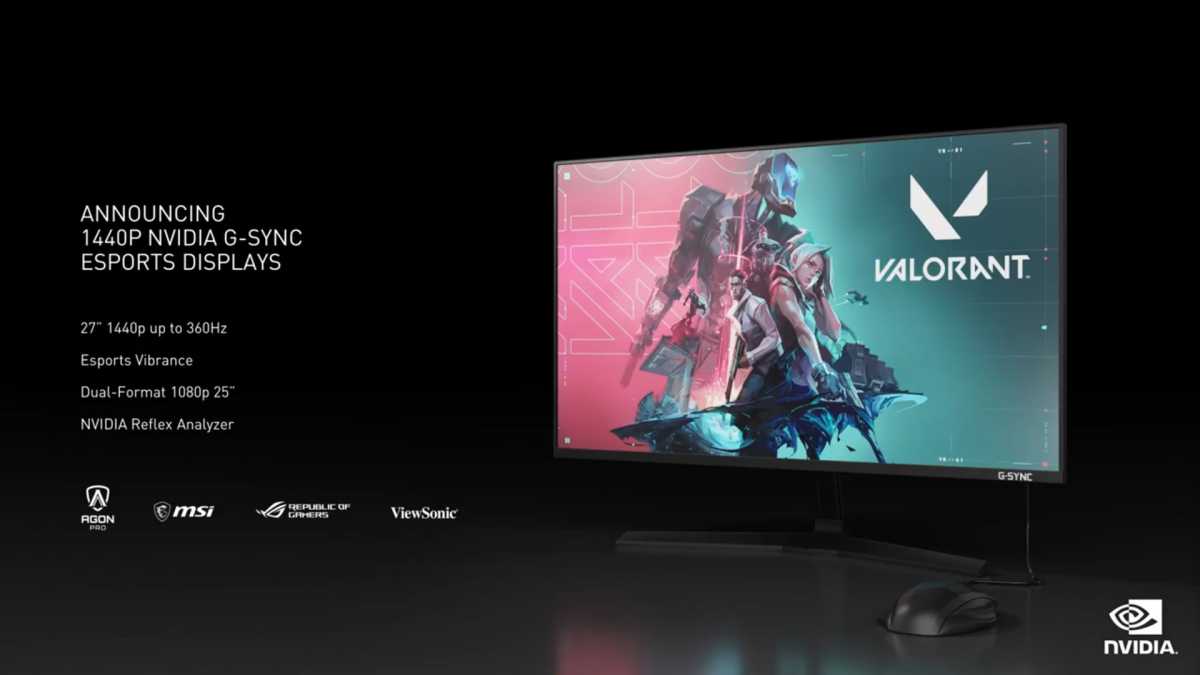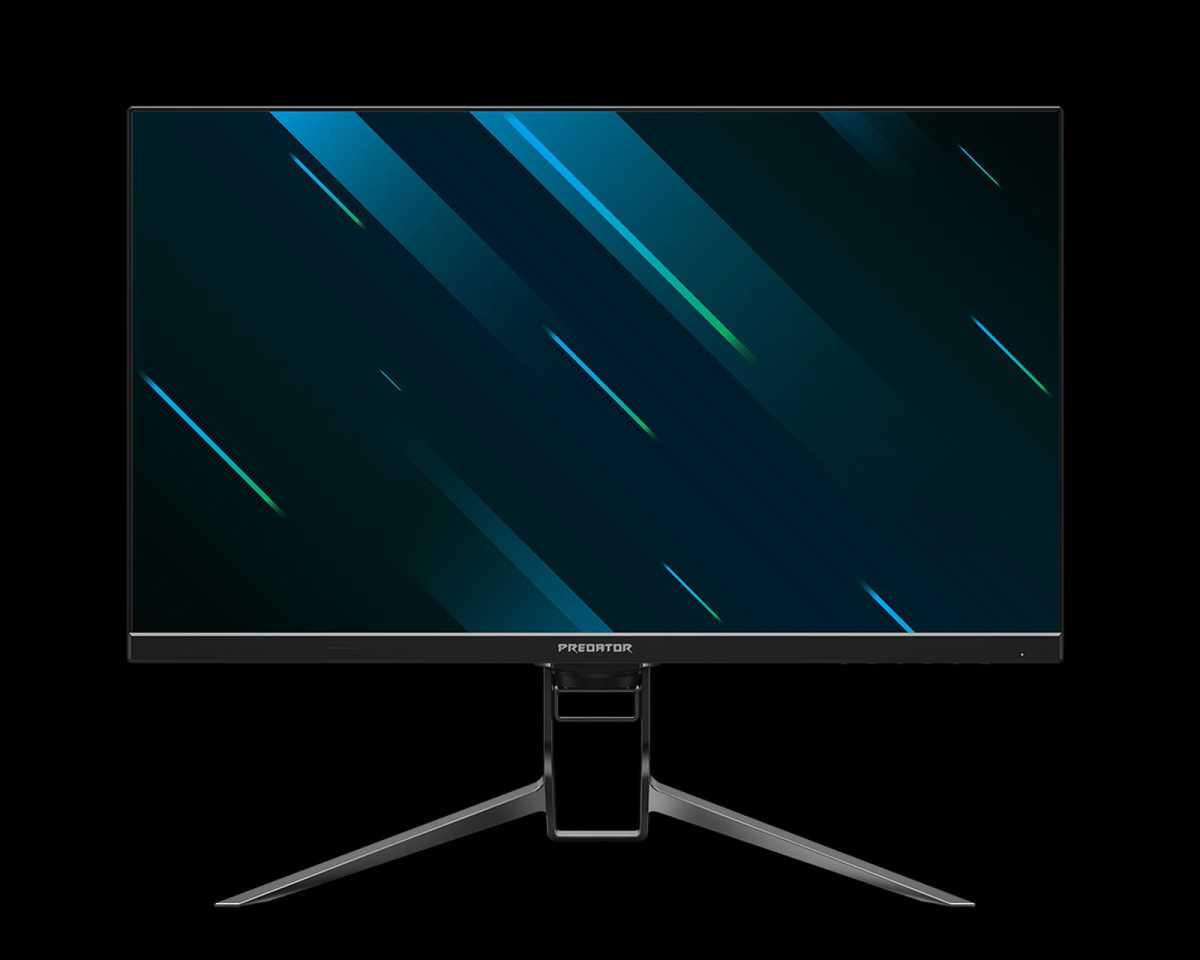5 monitor trends from CES 2022 you can't ignore

 Image: Asus
Image: AsusCES 2022 is an important show for PC monitors. The presence of display giants like LG and Samsung sets the tone for the coming year while smaller monitor makers tease announcements for upcoming flagships.
Many monitors shown at CES 2022 won’t arrive until the latter half of the year, and pricing remains in short supply. Still, the show can help you decide between upgrading a monitor now or waiting for the next holiday shopping season.
Here’s a rundown of the most important monitor trends from CES 2022. For even more CES coverage, be sure to check out our roundup of five laptop trends you can’t ignore.
Nvidia wants to make gaming monitors bigger and faster
Nvidia came to CES 2022 touting the benefits of 27-inch, 1440p monitors with a 360Hz refresh rate as an alternative to traditional 25-inch, 1080p esports monitors.
1440p at 360Hz is new, but 27-inch monitors are extremely common. In esports, however, 25-inch monitors remain the standard. Professional players often have an almost superstitious attachment to not only a particular monitor size, but a particular brand and panel technology.

Nvidia
Nvidia
Nvidia
Nvidia’s argument for the upgrade? A 27-inch 1440p monitor provides a larger, sharper view of the game. The company claims this can increase accuracy in shooters by up to three percent. That’s not a lot, but any tangible edge is important to professional players fighting for a championship title.
I must mention Nvidia has skin in this game. Pushing monitors to higher resolutions and refresh rates is good for Nvidia’s bottom line, as powering those experiences demands more potent graphics cards, so the company’s claims deserve skepticism.
Still, I see the potential. Rallying professional and casual players around the 27-inch 360Hz standard at 1440p could lead to a class of mainstream gaming monitors that handle all genres and play styles with little or no compromise.
That’s if esports players go for it, of course—and converting them could be a challenge.
Mini-LED gets a little more affordable
I’m bullish on Mini-LED monitors. The lack of burn-in and the potential for excellent HDR performance makes them a superb choice for both office settings and hardcore gaming. I don’t own one, however. Why? Well, they’re really expensive.
That’s not going to change in a year, but CES 2022 provides hope. First up is the Acer Predator X32 and X32 FP, a pair of 32-inch monitors with 576 Mini-LED zones (the X32 supports G-Sync Ultimate but not HDMI 2.1, while the X32 FP supports HDMI 2.1 and FreeSync). They pack 4K resolution and a refresh rate up to 165Hz.

Acer
Acer
Acer
The Predator X32 will retail for $1,999 and the X32 FP will go for $1,799, with both expected to arrive in Q3 2022. That’s not cheap, but it’s a lot less than 2021 Mini-LED monitors like the Asus ROG Strix PG32UQX, which released with an MSRP of $2,999 (it currently retails for $2,549 on Amazon).
Samsung is entering the 32-inch Mini-LED arena with the Odyssey Neo G8. It will serve 4K at up to 240Hz and boasts Quantum Dot technology. Samsung hasn’t clarified the Mini-LED dimming zone count or the price. However, Samsung’s 49-inch Mini-LED super-ultrawide, the Odyssey Neo G9, retails for $2,499. I’d expect Neo G8 to retail for less than that.
Mini-LED is headed in the right direction, and certainly remains competitive with OLED monitors. Perhaps we’ll see it hit sub-$2,000 price points at next year’s CES.
42-inch OLEDs offer a new option
PC enthusiasts are mad with envy for the excellent Sony and LG OLED televisions console gamers can enjoy for less than $1,500. Some even try to use televisions as monitors. This often doesn’t work well, as even 48-inch TVs are too big to use at a desk. Sitting so close can cause eye and neck strain and makes 4K resolution look less impressive.
CES 2022 brings a new solution: 42-inch OLED displays. You can choose from two flavors. Those who want an affordable, general-purpose option can opt for LG’s new 42-inch C2 OLED. If you prefer a straight-up monitor, however, you might consider Asus’ ROG Swift OLED PG42UQ.

LG
LG
LG
A 42-inch screen is still too large for use on a typical desk, but it’s viable if you’re willing to rearrange your setup or wall-mount the OLED as a secondary display for games and video. PC gamers who stick to cross-platform titles with gamepad support will find it especially tempting.
Pricing has not been announced for either 42-inch OLED. LG’s 48-inch C1 OLED carries an MSRP of $1,299, so the 42-inch model will likely be less expensive. Don’t expect a big discount, though. The 48-inch C1 OLED is only $200 less than the 55-inch model.
QD-OLED makes its debut
OLED is great, but it’s not perfect. The technology has issues with sustained brightness, can consume significant power on large displays, and is haunted by the spectre of burn-in. QD-OLED, short for OLED displays with Quantum Dot technology, is the latest effort to dismantle these shortcomings.
The technical details are complex, but much of it boils down to efficiency. QD-OLED can produce a wide range of colors more efficiently than prior OLED panels which, in the case of a display, means a higher percentage of the light from the OLED panel reaches the viewer. That translates to improved brightness and can even help with burn-in. QD-OLED improves color gamut and accuracy, too.
However, the point most important for PC owners is extremely simple: QD-OLED monitors actually exist! And they might come out this year!

Dell
Dell
Dell
Dell has announced the Alienware AW3423DW, a 34-inch ultrawide OLED monitor with 3,440 x 1,440 resolution and a 175Hz refresh rate. It’s also VESA DisplayHDR 1000 certified. Samsung has a nearly identical QD-OLED ultrawide called the Odyssey G8QNB.
Unfortunately, details about price and release date aren’t available. Televisions shown at CES typically arrive in late spring or in summer of the same year, and I wouldn’t expect QD-OLED monitors to appear before them. Pricing? It’s likely to be astronomical. Still, a 34-inch ultrawide OLED would be a dream display for many PC setups.
Things get…unique
CES is an opportunity to get weird, and 2022 was no exception. Samsung and LG came to the show with strange displays that offer a new take on how monitors should be usd.
Samsung’s Odyssey Ark is a 55-inch curved monitor on a massive stand that can rotate the display between landscape and portrait orientation. The company imagines PC users playing games in landscape mode and then switching to portrait orientation for a massively vertical productivity.
Here is a first look at the INSANE Odyssey Ark from @Samsung! This is a curved 55″ 4K Monitor with a 16:9 aspect ratio… Can do some serious gaming/multitasking on this! #ces #samsung pic.twitter.com/Y82hbeY9gg
— Tim Schofield (@qbking77) January 5, 2022
Let’s be real. A 55-inch curved display in portrait mode is useful only for early onset arthritis of the neck, and the landscape orientation is too big for gaming at a desk. Despite this, Samsung plans to bring it to market. This wouldn’t be a shock, as Samsung went to stores with the nutty rotating Sero television it debuted at CES 2020.
LG brought a more modest take on the vertical monitors with its funky DualUp 28MQ780. The DualUp is a 28-inch monitor with a 16:18 aspect ratio. That’s nearly square. LG says it’s similar to stacking two 21-inch monitors on top of each other. The focus on vertical use remains odd, but its reasonable size is less likely to turn your neck into a pretzel.

LG
LG
LG
These monitors, though silly, are a response to the move towards remote work. Samsung and LG seem to think vertical monitors will be attractive. Dell and Lenovo, meanwhile, think built-in webcams are a good idea. I doubt either idea will catch on, but it’s fun to see monitor makers experiment with out-of-box ideas.
Conclusion
CES 2022 was a good year for monitors, though not everything PC enthusiasts hoped. OLED and Mini-LED technology displays remain out of reach for many. The monitors shown at CES 2022 show prices are starting to come down but, as I’ve explained before, it’ll likely be years before they’re truly affordable.
Still, monitors are moving in the right direction. Given the lack of progress over the past five years, PC enthusiasts will have to take what they can get.
Author: Matthew S. Smith
Matthew S. Smith is a freelance technology journalist with 15 years of experience reviewing consumer electronics. In addition to PCWorld, his work can be found on Wired, Ars Technica, Digital Trends, Reviewed, IGN, and Lifewire. Matthew also covers AI and the metaverse for IEEE Spectrum and runs Computer Gaming Yesterday, a YouTube channel devoted to PC gaming history.
Recent stories by Matthew S. Smith:
Best monitor arms 2024: The ultimate in flexibilityPixio PX248 Wave review: A monitor for fashion, flair, and clarity on a budgetBest portable monitors 2024: Displays that go with you






